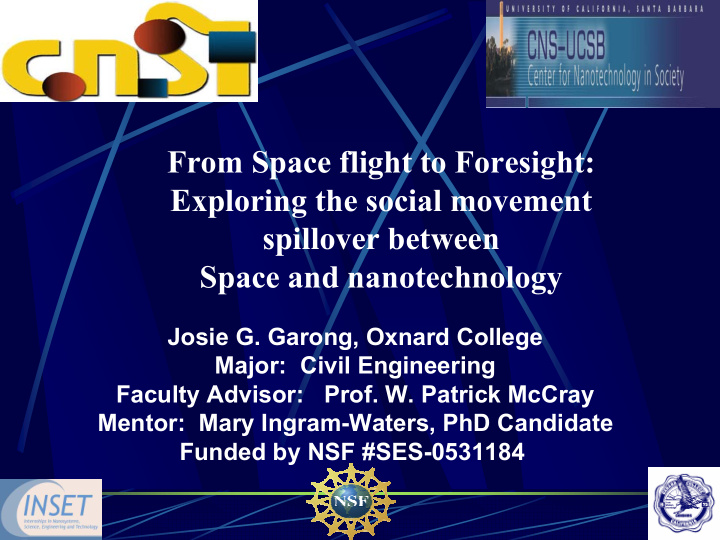



From Space flight to Foresight: Exploring the social movement spillover between Space and nanotechnology Josie G. Garong, Oxnard College Major: Civil Engineering Faculty Advisor: Prof. W. Patrick McCray Mentor: Mary Ingram-Waters, PhD Candidate Funded by NSF #SES-0531184
Space-Nano 1970s & 1980s 1980s & 1990s Movement Pro-Space Movement Pro-Nano Movement + = Nanotubes - httpwww.space.com071307 www.sciencenews.org/articles/20021005/bog9.aso071307 www.nssdc.gsfc.nasa.govdatabase_master catalog071307
Through historical exploration of nanotechnology… clifton.mech.northwestern.edu/~me381/project/ Anticipate future societal and ethical implications of nanotechnology View nano as an effort to develop technological solutions to social and economic problems Historians of science and technology have an opportunity, perhaps even a responsibility to challenge the “standard model” of nanotechnology history www.nasa.gov/.../133824main_cargo_high.jpg072507
The Standard Model of the Nano Nano History History The Standard Model of the Standard model is used to frame general articles 1959 - Richard Feynman’s famous speech - “Plenty of Room at the Bottom” 1986 – Eric Drexler published the book “The Engines of Creation” Nobel prize G. K. Binnig and H. Rohrer – scanning tunneling microscope 1996 - Nobel prize Richard Smalley – helped discover buckyballs 2000 - Passage of the National Nanotechnology Initiative 1959 1959 2000 2000 1986 1986 www.case.edu/news/2004/9-04/smalley_photo.jpg072107 www.research.ibm.com/images/about/nobel.jpg072107 1996 1996 1986 1986 blogs.britannica.com/blog/main/wp- blogs.britannica.com/blog/main/wp -content/uploads/2007/03/image6.jpg072307 content/uploads/2007/03/image6.jpg072307
Hidden histories of nano is the alternative to established versions of its historical stories …probing the possibilities probing the possibilities … History of modern science and technology � Supplements taken-for-granted origin of stories Nano’s science fiction roots � Gives interesting clues about its current status � “What ifs” of scientific innovation Nano’s emergence in the public imagination � Science advocacy groups with futuristic goals www.battelle.org/.../Summer2003/gfx/question.jpg072107
Research Methodology Research Methodology Target population: pro-space and pro-nano advocacy groups Data Analysis Data Sources Scanning texts Primary source materials Organizing -Newsletters – e.g., L5 Coding -Web materials -Interviews -Thematic elements -Policy documents e.g., Drexler, nanotechnology, -Funding sources -Contributors
Data Collection Scan document Gather lots of data Gather lots of data Convert to searchable PDF file
After data collection… Looking for keywords Looking for keywords Use find command - keyword – e.g., nanotechnology - author – e.g., Drexler - phrase where keyword used Chart citation example in Excel file
Next Step � Make more definitive claims about people who moved between the pro-space and pro-nanotechnology movements. � Narrow findings to elucidate mechanisms by which public imagination was evoked regarding nanotechnology.
Acknowledgements MY SINCERE THANKS Dr. Evelyn Hu, Scientific Director of CNSI Dr. Barbara Herr Harthorn, Director of CNS Dr. Fiona Goodchild, CNSI Education Director Liu-Yen Kramer, CNSI Education Co-Director Prof. W. Patrick McCray, Faculty Advisor Mary C. Ingram-Waters, Mentor Emily Kang, CNS Education Coordinator Samantha Freeman, INSET Coordinator Dr. Nick Arnold, INSET Community College Liaison Luke Bawazer, INSET Supermentor To my colleagues and all the others who helped me
The End www.nanooze.org/image/spaceelevator.jpg072507
Less examined histories of nanotechnology - Molecular Beam Epitaxy (MBE) - perfected in the1970s – John Arthur and Al Cho – Bell Laboratories – development of MBE allows for the precise fabrication of new materials and nano-structures predates the scanning and atomic forces microscopes of the 1980s Molecular Beam Epitaxy 1968: Bell Labs' Al Cho (right) develops molecular beam epitaxy, a technique that enabled semiconductor chips to be made one atomic layer at a time, opening the door to vast improvements in chip manufacturing. http://www.alcatel http://www.alcatel- -lucent.com/wps/portal/BellLabs072207 lucent.com/wps/portal/BellLabs072207
Science fiction roots - A role of public imagination in fostering policies for nano research - Public visions of future technologies play an important role in establishing support or opposition for policy - Futurist groups – cultivate an environment of technological optimism within - Political and social acceptance of new technologies like nano could fluorish Example: futurist groups initially devoted to promoting the space frontier in the 1970s shifted to pro-technology Activism, including nano, in the 1980s McCray, W. Patrick (2007) “Exploring Nanotechnology’s Hidden History” http://www.aip.org/history/newsletter, July 19.
Additional Data Gathered
Microtechnology technology with features near one micrometre micrometre - technology with features near one - - one millionth of a metre, or 10 -6 metre, or 1µm - led to Industrial Revolution led to Industrial Revolution - - 1960s 1960s – – arrayed large numbers of microscopic arrayed large numbers of microscopic - transistors on a single chip transistors on a single chip microelectronic circuits could be built - microelectronic circuits could be built - - improved performance, functionality and reliability improved performance, functionality and reliability - - - - cost effective and decreased volume cost effective and decreased volume - - -
The bottom-up approach These seek to arrange smaller components into more complex assemblies. materials and devices are built from molecular components which assemble themselves chemically by principles of molecular recognitionConstruct well-defined structures out of DNA and other nucleic acids
The top-down approach These seek to create smaller devices by using larger ones to direct their assembly. - nano-objects are constructed from larger entities without atomic-level control Many technologies descended from conventional solid- state silicon methods for fabricating microprocessors are now capable of creating features smaller than 100 nm, falling under the definition of nanotechnology.
Recommend
More recommend